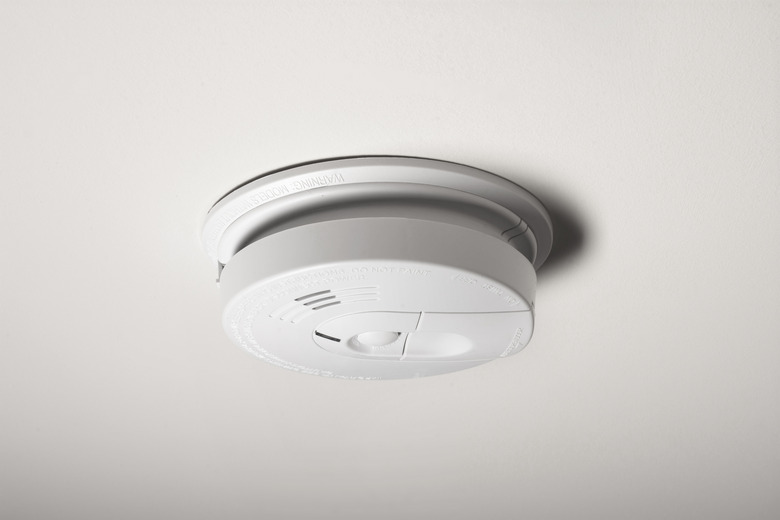Differences Between Smoke Alarms And Carbon Monoxide Detectors
We may receive a commission on purchases made from links.
When someone tells you that an inexpensive appliance could save your life, it's smart to listen. Unfortunately, many people ignore this wise counsel by failing to install smoke alarms and carbon monoxide detectors in their homes. Both of these devices save lives, although they do so in different ways. Smoke detectors alert you to the presence of smoke and possibly fire in your home. Carbon monoxide detectors alert you to dangerous levels of carbon monoxide gas.
Tip
Carbon monoxide and smoke detectors can both save lives by detecting threats and warning residents. They detect the threats in different ways but have other similarities.
Why They Matter
Why They Matter
Sometimes people skip the smoke alarm because they feel the presence of fire is obvious. Even if the fire is burning inside the walls or on a different floor of the house, eventually you will smell the smoke or see the flames. This claim is true, but those who make it fail to realize that fire victims usually die from smoke inhalation rather than from the heat or flames. If you're sleeping when a fire starts, you could die of smoke inhalation without ever realizing you were in danger.
Carbon monoxide kills in much the same way but is impossible to detect without a detector. In the early stages, carbon monoxide exposure will make you dizzy, nauseous, short of breath, weak and confused. Your vision may blur and you will ultimately lose consciousness. These symptoms occur because as you inhale it, carbon monoxide replaces the oxygen in your blood, delivering a dangerous chemical — instead of oxygen — to your cells. Unlike fire, which may give you some warning, carbon monoxide is odorless, colorless and tasteless, so you won't see it coming.
A number of household appliances emit carbon monoxide, including gas stoves or ovens, gas furnaces, water heaters and space heaters. Because its symptoms are similar to the flu (nausea, headache, dizziness, light-headedness, confusion), the initial stages of carbon monoxide poisoning are difficult to recognize and are often overlooked.
How They Work
How They Work
Smoke alarms detect smoke in two ways. One method, called photoelectric detection, uses a light beam sensor that triggers an alarm when smoke particles break the light beam. Other smoke detectors, known as ionization detectors, pass a small electrical current from one diode to another. These alarms sound when smoke particles interrupt this electrical current. Some newer smoke alarms also detect heat.
Carbon monoxide detectors work in one of three ways. Biomimetic sensors contain a gel that changes color when it absorbs carbon monoxide. The carbon monoxide detector monitors the color of this gel and sounds the alarm when it changes.
Other detectors use a metal oxide semiconductor. This semiconductor is similar to the chips on an electronic circuit board and contains silica, which is sensitive to the presence of carbon monoxide. When it detects the gas, it reduces the amount of current flowing through the detector to trigger the alarm. The final option is an electrochemical sensor. In these detectors, small electrodes rest in a chemical solution that changes when exposed to carbon monoxide, sounding the alarm when they sense this change.
Smoke and CO Alarms Need Power
Smoke and CO Alarms Need Power
Both smoke and carbon monoxide alarms need a power source to operate. Some units operate independently of your home's electricity and rely on a battery. If you opt for this type of detector, hold down the test button once a month to make sure the unit is still working. Change the batteries once a year, or use a lithium-ion battery that needs to be changed only once every five years. If you remove a pesky smoke alarm battery while cooking, you must remember to put it back promptly.
Some smoke detector and carbon monoxide units plug into an electrical outlet or get wired directly into your home's wiring system. Sometimes incorporated into a home security system, these detectors often have a battery backup that keeps them working when the power goes out. Though a bit trickier to install, hardwired detectors are generally more forgiving since you don't have to remember to maintain them as often as you do battery-powered units. Hardwired units also typically are interconnected so if one alarm goes off, all connected alarms are triggered.You can also provide interconnection with wireless units.
Where They Should Be
Where They Should Be
Smoke alarms save lives only if they alert people to smoke. Having a smoke detector in the basement while you sleep on the top floor of the home makes it unlikely that you'll hear it. The best practice is to place smoke alarms in or just outside of each bedroom. You'll also want at least one on every floor of the house, including the attic and basement.
Like smoke alarms, install carbon monoxide detectors near sleeping areas and make sure there is at least one on every floor of your home. In addition, you can install carbon monoxide detectors near gas furnaces or appliances or just outside of your garage. Wood burning fireplaces, too, can create carbon monoxide, so mount one in the room with your fireplace if you use it. Be sure to check the manufacturer's installation instructions; many detectors should not be installed within 20 feet of gas-burning appliances.
